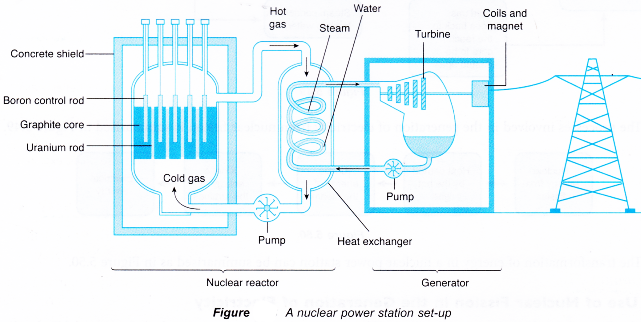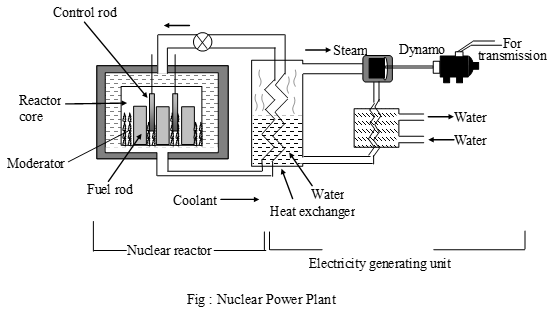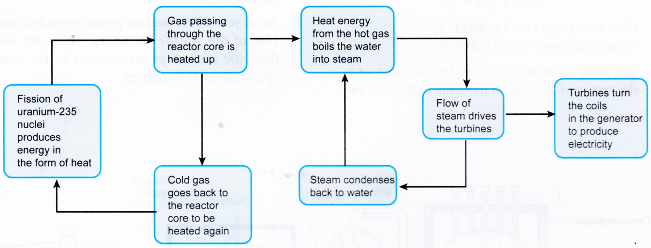How does a nuclear power plant works?
How do we convert nuclear energy into usable energy?
- At electrical power stations, turbines turn their rotors to produce electricity by electromagnetic induction.
- At a nuclear power station, the energy released by nuclear fission reactions is used to drive these turbines.
- As of year 2005, nuclear power provided about 15% of the world’s electricity. There are more than 400 nuclear power reactors in the world, operating in 31 countries.
Components of a Nuclear Power Plant:
The functions of the different parts of the reactor and generator is summarised below.
- Uranium fuel rod: The nuclei are split by neutrons in a controlled chain reaction releasing a large amount of energy. The energy released heats up the cold gas that passes through the reactor core.
- Boron control rods: The boron control rods absorb neutrons. When the rods are lowered into the reactor core to absorb some of the neutrons, the rate of the fission reaction is reduced.
- Graphite core: Acts as a moderator to slow down the fast neutrons produced by the fission. Slower neutrons are more readily captured by the uranium nuclei.
- Concrete shield: It prevents leakage of radiation from the reactor core.
- Coil and magnet: The magnet is rotated by the turbines. Electricity is generated by electromagnetic induction.
- Nuclear reactor: Here, a controlled nuclear fission of a fissionable fuel such as is carried out.
- Heat exchanger: Heat energy from the very hot gas is used to boil the water into steam. The reactor is connected to heat exchanger. Here, the heat produced in the reactor is transferred to water by circulating a coolant through a coiled pipe. The water gets converted into steam. The coolant is pumped back to the reactor.
- Steam turbine: The turbines are rotated by the flow of steam under high pressure. The steam generated in the heat exchanger is used to run the steam turbine. The spent steam is sent back as hot water to the heat exchanger.
- Electric generator (or dynamo): The shaft of the steam turbine is connected to an electric generator (or dynamo). Electricity so produced is sent for transmission.

People also ask
- What is Nuclear Energy?
- What is nuclear fission and how does it occur?
- How is energy released in a nuclear fusion reaction?
- What happens in a nuclear chain reaction?
- Radioactivity: Types of Radioactive Emissions
- How do you detect radioactivity?
- What is nucleus of an atom?
- What is the half life of a radioactive element?
- What are the different types of radioactive decay?
- What are the Isotopes, Isobars and Isotones of an Element
- What is the Radioactive Isotope?
- Importance of Proper Management of Radioactive Substances
- What are the Sources of Energy?
- What are the Non Conventional Energy Resources?
- What are the Conventional Energy Resources?
- Advantages and Disadvantages of Electricity Generation
How does a nuclear power plant works?
Nuclear Power Plant and it’s Working: Electricity From Nuclear Energy
The heat produced in a controlled fission can be used for producing electricity. The set–up used for generating electricity from the heat released in a controlled nuclear fission is called a nuclear power plant or nuclear power station. A nuclear power station consists of a,nuclear reactor and a generator, as shown in Figure. The heat produced in a controlled nuclear fission is used for producing steam. The steam so produced runs the turbine. The rotatory motion of the turbine rotates the alternator of the generator and the electricity is produced. Thus, in a nuclear power plant the energy transforms in the following sequence
Nuclear energy of uranium–235 nucleus → Heat energy of steam → Kinetic energy of turbine → Kinetic energy of the alternator → Electrical energy

The processes involved in the generation of electricity from nuclear fission is summarised in Figure.
 The transformation of energy in a nuclear power station can be summarised as in Figure.
The transformation of energy in a nuclear power station can be summarised as in Figure.

How many nuclear power plants are there in India?
Location of Power Station in India:
At present about 3% of the electrical energy produced in India is obtained from nuclear power stations (also called atomic power stations).
The following atomic stations are in operation in India
- Tarapur atomic power station (420 MW) in maharashtra.
- Rajasthan atomic power station (440 MW) at Rana Pratap Sagar near Kota in Rajasthan.
- Madras atomic power station (420 MW) at Kalpakkam in Tamil Nadu.
- Narora atomic power station (470MW) near Bulandshahar in Uttar Pradesh.
The Use of Nuclear Fission in the Generation of Electricity
- The demand for electricity to power the world is increasing as advances are made in Science and Technology.
- Electrical power is generated mainly from the burning of fossil fuels such as oil, coal and natural gas. Fossil fuels contribute to more than 70.% of the energy needed to generate electricity.
- There are two main concerns in the use of fossil fuels:
(a) The burning of fossil fuels release large amounts of heat and gases into the environment.
(b) Fossil fuels are non-renewable sources of energy and reserves are fast running out. - Since the 1950’s, energy from nuclear fission has been used to generate electricity.
- There are more than 400 nuclear power stations across the world. They produce about 17% of the world’s electricity.
- In Asia, the use of nuclear energy has been growing significantly. In East and South Asia there are over 100 nuclear power reactors in operation and about 20 more under construction.
- Japan generates 29% of its electricity from nuclear power and South Korea meets 38% of its electricity needs from nuclear power.
- There has been an on-going debate about the pros and cons of using nuclear energy to generate electricity.
What are the pros of nuclear energy?
The advantages of using nuclear energy:
- Nuclear power stations need less fuel than power stations which burn fossil fuels to produce the same amount of electrical power.
- There are vast reserves of nuclear fuel such as uranium which is spread evenly throughout the world.
- The emission of carbon dioxide from nuclear power stations is minimal. It does not greatly add to the greenhouse effect.
- It does not produce gases such as sulphur dioxide which affects the health or produces acid rain.
- The amount of waste from nuclear power stations is much less than power stations which use fossil fuels.
- The reactor in a nuclear power station can be used to produce useful radioisotopes that can be used in the industry, in the medical and agricultural fields and for research.
- The price of nuclear fuel is more stable compared to fossil fuels.
- Very advanced safety procedures are being observed in the administration of nuclear reactors. There has been a very good safety record in nuclear power production.
What are the disadvantages of using nuclear energy?
The disadvantages of using nuclear energy:
- The initial cost to design and build a nuclear power station is many times the cost of building an oil-powered station.
- Nuclear power stations produce waste in the form of used fuel rods which are very hot and highly radioactive and with half-lives of up to thousands of years. Expensive procedures are required to cool down the rods and to store them.
- The hot water discharged from nuclear power stations causes thermal pollution to the environment.
- People who work in nuclear power stations and those who live nearby may be exposed to excessive radiation.
- There is always a risk of accidents. If the chain reaction goes out of control, the reactor will overheat and a meltdown will occur. This may lead to the leakage of large amounts of radioactive substances to the atmosphere, the soil, underground water and rivers.
- The nuclear fuel could be enriched and used to produce weapons of mass destruction.
The post How does a nuclear power plant works? appeared first on A Plus Topper.
from A Plus Topper
via Learning Made Simple 360
*Note that these contents are Autoblogged from A Plus Topper and cannot be edited.
Join the conversation